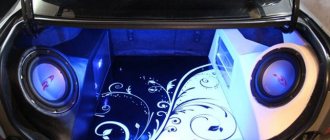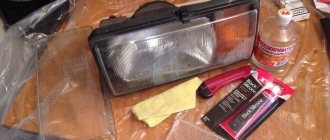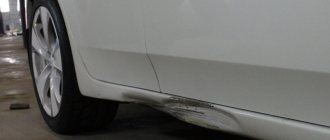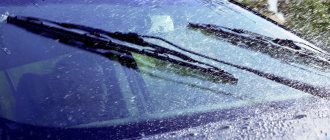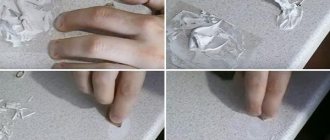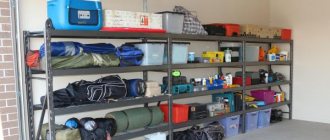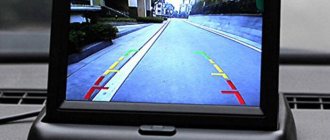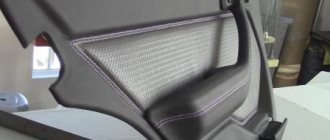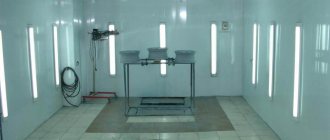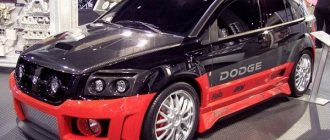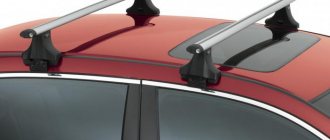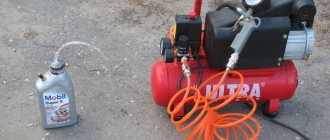Comments: no Published: 11/27/2015
Rating:
Tags: Body hood
Body stretching is a very complex process, which is usually performed after an accident, when all distortions in the geometry of the car body are eliminated by applying the opposite force to that received during the accident.
What does it take to pull out damage?
To correct damage of this nature, special tools are always used that can return any part of the car to its previous state; these are hydraulic and screw jacks, which can be used on:
- doorways,
- hood and trunk lid,
- openings of the windshield and rear glass.
How much a body stretching costs always depends on the method of work, but sometimes you can repair a car after a minor collision, for example, unsuccessful parking, with your own hands.
To perform straightening with your own hands using the heating method, you need to arm yourself with:
- rubber or metal hammers of different weights;
- protective equipment - gloves, glasses;
- heat source - burner or hair dryer.
Body pulling
Effective methods for pulling out and repairing dents on cars
During the operation of the car, scratches, chips and dents appear on the body. The reason for their appearance can be both negative environmental factors and careless driving. Chips and scratches are painted over. Repairing and pulling out dents on a car is carried out using various methods and devices that allow you to eliminate metal jams.
How it works?
Leveling the body shape using jacks should occur in several stages:
- Dismantling all parts that in any way interfere with repairs and access to damaged areas.
- Installing the car body on special supports.
- Installing a hydraulic jack and determining the impact angle.
- Starting the hood. During the pulling process, it is always very important to take measurements with a special body ruler and compare the indicators according to the control points of the primary body drawing.
- While pulling, the mechanics also “tap” with a hammer on all the distortions and bends of the metal, which helps give the body its original shape.
- In cases where the first time it was not possible to pull the parts into their previous position, repeated pulling with squeezing is performed, and everything is left in this position for a day for the metal to “get used to.” If the damage is very extensive, then two or three jacks can pull out the dent at once.
This method may involve the use of a vacuum in cases where the concave part has retained the integrity of the paint layer; it will avoid the need to do “cosmetics”. It may cost more, but considering how much it costs to paint a car, such a hood is still cheaper.
Locations for installing body pulling equipment
It is also possible to use a reverse hammer, but painting cannot be avoided here. The method works like this:
- A hook made of thick wire is welded to the bent section.
- A reverse hammer is attached to the hook, which with blows will pull the metal to its original position.
- When the process is successfully completed, the snags are cut off and the body is sanded and painted.
Sometimes, to install a reverse hammer, a hole for a hook may be drilled into which a nut and washer are threaded. Once completed, the hole is treated with putty or welded.
Another method of repairing the body is stretching using a gas torch; it is mainly used to upset the stretched metal and smooth out folds. Here you need to work very carefully, keeping the burner at a distance, otherwise there is a risk of burning the body.
Please note that the hood must be completed in a timely manner. This means that you must complete all work at the same time as the surface has completely cooled, otherwise it may return to the wrong position.
Car straightening stand
The most popular among devices for eliminating deformations of the car body is a special stand:
- The body is installed on it and secured with clamps at four points for reliable fixation - at the points where the car floor connects with the thresholds.
- Suitable grips are selected based on the location of the damage. They are then attached to the vehicle and the correct pull angle is set.
- Hydraulic jacks are launched, which perform preliminary stretching of the body. After this, control measurements are taken, and if necessary, the process is repeated.
- Next, the body is straightened.
Also worthy of attention is the easiest way to repair deformations - dismantling the damaged part using an amplifier, which with a 6 mm drill will pass along the perimeter of the weld and separate part of the body from the body. It is straightened and welded into place.
If the entire body is being repaired, then it is necessary to prevent the doors from sagging by placing special trestles under the front and center pillars in the amount required for reliable support.
Correct putty
Before you putty the car body with your own hands, you need to prepare. This will help avoid visible defects after painting the car:
- Sand and remove excess metal bulges.
- Degrease and clean the treated surface. In some cases, the operation is performed several times.
- Repair the repaired area of damage by applying putty evenly in several layers.
- After it dries, the surface is sanded. It is important to ensure that the putty layer is flush with the rest of the surface of the car body.
- Apply primer in two layers.
- Paint the surface using a spray gun. Apply varnish and polish the surface.
Measuring the “geometry” of the body
p, blockquote 6,0,0,0,0 —>
To understand where and how much the power elements of the body have shifted, various measuring systems are used to measure geometric parameters.
p, blockquote 7,0,0,0,0 —>
Most often, in garage workshops and small car repair shops, rulers are used to measure body geometry, as well as simple tape measures.
p, blockquote 8,0,1,0,0 —>
It is not always convenient to use a tape measure, since there may be various obstacles on the path of the two points between which you need to measure the distance (especially in the engine compartment). A measuring ruler allows you to take measurements quite easily (see the article on measuring body geometry).
p, blockquote 9,0,0,0,0 —>
It is important to check the diagonals of the shock absorber cups and the mounting points of the suspension to the body. These parameters affect the wheel alignment setting.
p, blockquote 10,0,0,0,0 —>
Leveling with reverse action tools
This method can be divided into two types. The first is that a vacuum tool is used for the job, and the second type involves the use of a reverse hammer. Both methods work on a similar principle, and you can understand the procedure by watching a video on this topic.
The technology of straightening with a vacuum tool is as follows. A tool with suction cups is attached to the damaged area of metal and with physical effort the dent is pulled out to its normal position.
This method is often used in cases where the paintwork remains intact at the damage site, since pulling with suction cups allows you to preserve the paint and avoid cosmetic repairs.
If a reverse hammer is used, then painting work cannot be avoided. The technology for pulling out a dent using this method is as follows: hooks made of wire are welded to the damaged area, a reverse hammer is connected to them, and the metal is pulled out to its normal position by impact forces. After this, the hooks are cut off, and the body is sanded and painted.
Another way to pull out a dent using a reverse hammer is to drill a hole. The threaded tip of the tool is threaded into this hole, and a washer is put on the other side and the nut is tightened. After leveling, the hole is puttied or welded. It should be noted that this method will be difficult to perform in cases where there is no access to the damage site on both sides. All these techniques require caution and some experience, so you first need to watch several videos with different options for such straightening.
Jib for pulling out the car body
In order to pull out the power elements of the body, as well as, in general, perform pulling operations, bodybuilders use a slipway. The slipway is designed for rigid fastening of the body and subsequent pulling out of its damaged elements. Fastening is usually done at the sill flanges. This is necessary so that the car does not move along with the pulled element.
p, blockquote 11,0,0,0,0 —>
p, blockquote 12,0,0,0,0 —>
Many garage body repair specialists do without the use of a slipway. To do this, garages use concrete hinges that are located along the perimeter of the garage floor. They serve both to pull the body (a winch or hydraulic tie is attached to them) and to secure the car with chains on the reverse side of the pulling force. If the front is pulled out, then the back of the car is tied with chains to the hinges; if the back is pulled out, then the front part is tied, accordingly. Also, stops are used when applying lateral pulling force.
p, blockquote 13,0,0,0,0 —>
More often, however, a slipway is used. Garage body repair specialists purchase stocks suitable for use in small workshops, and also copy and manufacture the designs of factory stocks, as well as assemble homemade stocks that they have come up with on their own. Large car repair shops use platform-type slipways.
p, blockquote 14,0,0,0,0 —>
Types of Dents
Before you straighten a dent on your car with your own hands, you need to know what types of damage exist. Dents on a car have different shapes and degrees of damage. Small defects usually appear on the roof and hood of the car due to hail and small stones. Medium and large metal fractures are a direct result of careless driving. Such dents on the car body can have a complex shape.
If the paint at the site of a large crease becomes cracked and begins to fall off, then, in addition to removing the dent, you will need to restore the paintwork. Otherwise, pockets of corrosion will form on the part of the body where the damage occurred.
Hydraulic stretch
p, blockquote 16,1,0,0,0 —>
p, blockquote 17,0,0,0,0 —>
Hydraulic stretching is used in body repair for stretching using the extrusion method. There are various hydraulic extensions that provide different forces from 4 tons and above. An example of the use of this device is pulling out the side pillars of the body by squeezing it out from inside the passenger compartment. Spars that are shifted to the side can be straightened. And also, straightening deformed doorways and windshield and rear window openings. Typically, bodybuilders purchase a set that includes several types of extensions of different lengths, attachments, the extension itself and a hydraulic pump, but you can buy each element separately.
p, blockquote 18,0,0,0,0 —>
Body clamps
p, blockquote 20,0,0,0,0 —>
p, blockquote 21,0,0,0,0 —>
To directly attach a chain from a pulling device (winch or tie) to a damaged element, various body grips are used.
p, blockquote 22,0,0,0,0 —>
Sometimes metal loops and plates with loops are welded in places where it is impossible to use a body grip, or in the absence of special grips.
p, blockquote 23,0,0,0,0 —>
Some modern body clamps have a self-clamping design. By adding pulling force, the gripper is compressed more, which prevents it from slipping out.
p, blockquote 24,0,0,1,0 —>
Indications for use
When stretching the body, sometimes you have to leave it on the slipway under load for a day. This is due to serious deformation of the power elements and the so-called metal memory effect. For example, when a spar has become too loose, a long constant load is needed to straighten it. It also helps to neutralize the mentioned memory effect. After all, a heavily deformed metal element, even after proper editing, may partially lose its restored geometry.
On the slipway it is possible to straighten the damaged front subframe without removing it from the car, and in some cases even the frame (with minor deformation). True, few undertake this last operation.
When restoring the body, be sure to check the geometry of the subframe and other suspension elements (struts and levers) - otherwise crooked wheel alignment angles are guaranteed, which cannot be corrected at the wheel alignment stand without replacing certain parts. In the worst case, this will lead to nervous behavior of the car on the road or increased tire wear. Remember: a strong violation of the wheel alignment angles does not mean that the body skeleton was pulled out poorly - first pay attention to whether the suspension elements are deformed.
Of course, there are also poorly performed works on the slipway. In addition to greatly reduced wheel alignment angles (and the associated consequences), crooked gaps between mounted body parts can be seen even with the naked eye. In addition, the doors or trunk lid may not close properly due to the fact that the openings remain skewed. However, often the reason is different. When restoring the body and replacing doors, craftsmen do not pay attention to the condition of the hinges. They may be visually smooth, but at the same time they will “pull” the doors in the openings, causing increased force when closing and opening.
Even with original body parts, sometimes you have to adjust the editing process. A complete match of the dimensions of the restored load-bearing frame at the control points does not guarantee that the gaps between the fresh hinged panels will be ideal. What can we say about non-original spare parts with varying sizes. Because of this, there is even such a thing as editing the body for specific (non-original) parts.
Pulling out the shock absorber cups
p, blockquote 25,0,0,0,0 —>
As mentioned above, when measuring the “geometry” of the body, it is important to check the location of the shock absorber cups. The diagonals of the segments are measured from the centers of the upper bolts for attaching the struts to the bolts for attaching the hood brackets to the body. Also, the diagonal distances between the centers of the bolts of both body cups are checked.
p, blockquote 26,0,0,0,0 —>
When moving the shock absorber cups, a special device is used. It allows you to pull the cup in any direction.
p, blockquote 27,0,0,0,0 —>
